
Let me tell you how I decided to buy a curry plant. It wasn’t exactly planned. Just a classic case of “well, if the universe insists, who am I to stand in the way?”
You know when you notice a thing (like a new word, for example) and then you keep coming across it over and over again? That’s what happened to me and the plant that smells like curry.
First, I noticed the oddity that is the curry plant in the Asian corner of a botanical garden I was visiting.
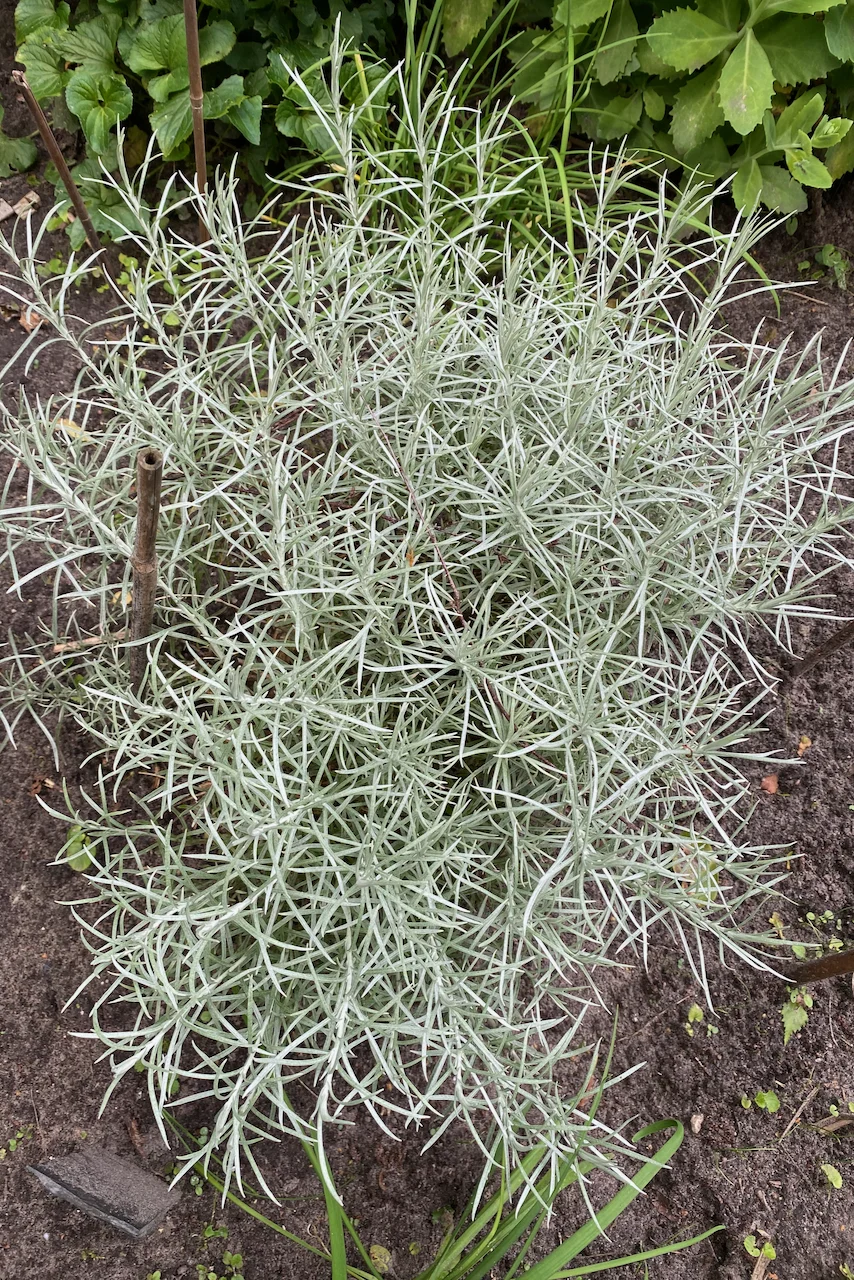
A few months later, after dinner at my friend’s house, she showed me a tray of herbs her in-laws had brought back as a souvenir from their travels. It included a curry plant – the only herb in that crate that I was not familiar with.
And just to seal the deal, the mighty Youtube algorithm started serving me videos of people growing this plant in their garden. (In the algo’s defense, I do watch a lot of gardening content.)
Ok, universe! If you keep winking my way, I’ll get myself one of these plants.
But what in the name of all that’s fragrant is a curry plant?
Curry plant – or curry herb – is the popular name for Helichrysum italicum. It is a tender perennial with needle-shaped silver leaves and yellow flowers. It looks quite similar to lavender and rosemary. And its moniker comes from the fact that the fresh leaves really do smell like the mix of spices used to make the delicious curry dish.
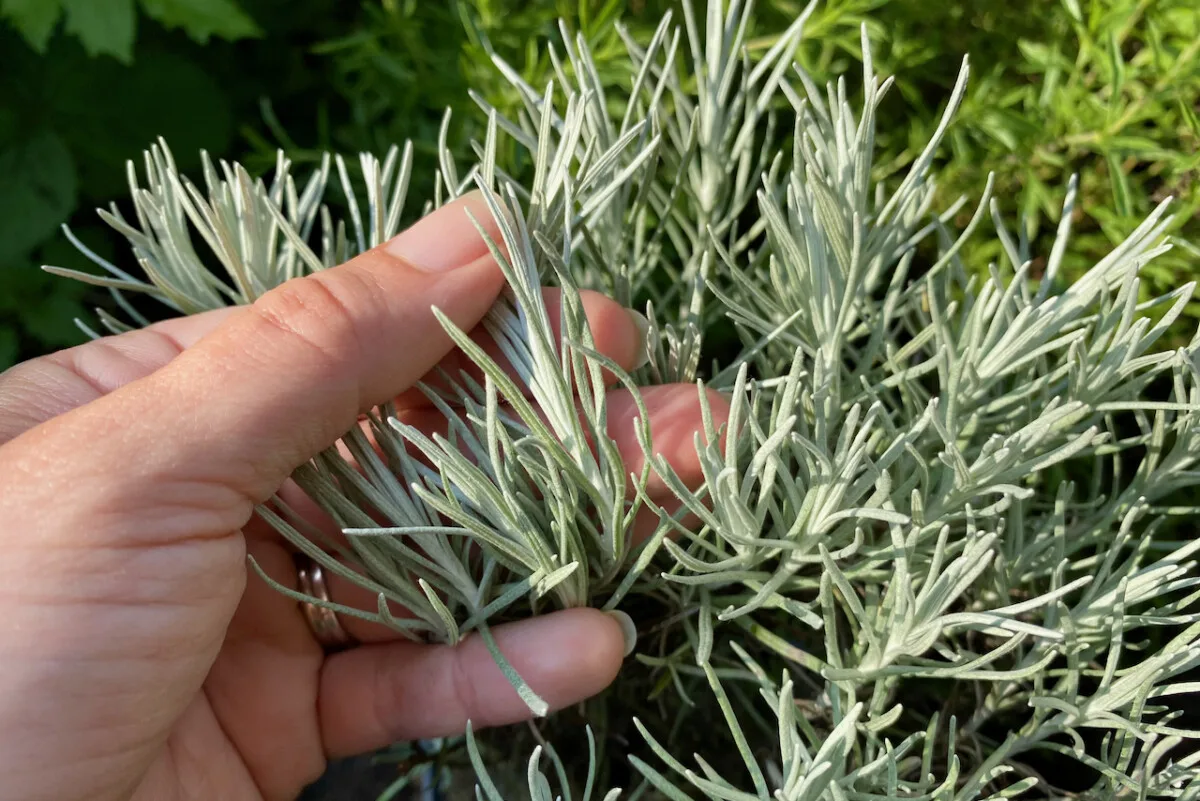
Another two names I found for Helichrysum italicum are Italian strawflower (a nod to its Mediterranean origins) and l’immortelle. A beautiful word that translates as everlasting or immortal (due to the skin rejuvenation properties of the essential oil extracted from the flowers.)
But let’s make things clear. The curry plant is not the same as the curry leaf tree (Murraya koenigii) whose leaves are used as flavoring in Indian and Asian cuisines.
If you were hoping to use this plant to whip up batch after spicy batch of curry, I’m sorry to disappoint you.

Why should I even plant the curry herb?
If all this talk of curry left you intrigued – and slightly hungry – consider this article your first sign from the universe that you should plant a curry herb. (And if you need more signs, come back and read it two more times.)
Here are a few reasons that convinced me to bring this plant into my garden.
1. The curry plant smells amazing.
Does the curry herb smell like curry? Yes, without a doubt. It has a pleasant curry fragrance. And I’m delighted to report it’s not just fragrant when you brush against the leaves. As soon as I brought this plant into the garden, I noticed that I get a nice whiff when the wind blows, especially after it rains.
I like the fragrance so much that I’ve bought several plants. I placed some at the back of the garden and a couple right along the deck. Just to give me more opportunities to brush gently past them and take in their scent.
I’ve written before about the important role that scent plays in a garden, so adding another scented plant to the mix was only natural. But unlike plants such as roses, jasmine and sweet peas, that are only fragrant when in bloom, herbs such as Helichrysum italicum will release their fragrance for much longer.

But what does the curry plant smell like, really?
Curry powder itself is a combination of cumin, turmeric, coriander, chili peppers and black pepper. Blends can vary from one region to another, even in the same country, so there are other variations that include fenugreek, cardamom and even ginger.
So it’s no wonder that to some gardeners the curry plant may smell primarily like one of these ingredients. Other descriptions I’ve heard liken its fragrance to maple syrup or cinnamon.
Overall, to my nose, the curry herb has a pleasant combination of sweet, floral and spicy aromas. But then again, smell is very subjective; so if you’re in doubt or not very partial to a good curry, see if you can smell the curry plant first before you buy it (i.e. don’t buy it online).
If you like the smell of the plant, there is a downside: it might make you crave curry even when it’s not on the menu.
2. It’s fairly easy to keep the curry herb happy.
Would I categorize the curry herb as a low-maintenance plant?
Yes, as long as you meet its basic needs. What do we talk about when we talk about plant needs? The three key elements: soil, light, water.
Here’s how the curry plant fares in these three categories.
The curry plant does best in sandy or loamy soil.
Being originally from a fairly arid and sandy environment, all the members of the Helichrysum genus will do best in sandy or loamy soil.
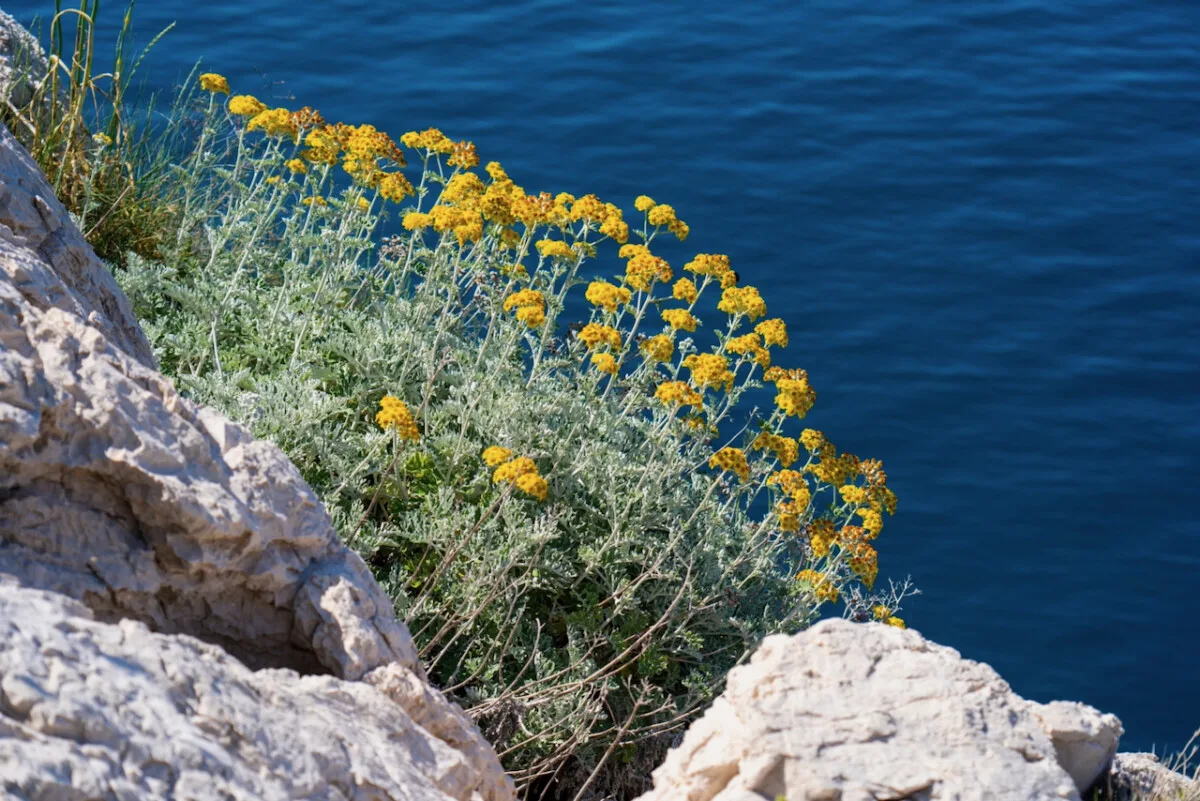
In the wild, plants in the Helichrysum genus can grow at a higher altitude of about 5500 feet (approximately 1700 meters) above sea level, in the crevices between rocks. So it’s a tough one.
The more sun the curry plant receives, the poorer your garden soil soil can be. With one caveat: the ground needs to drain well. Curry plants don’t like moisture collecting around the roots.
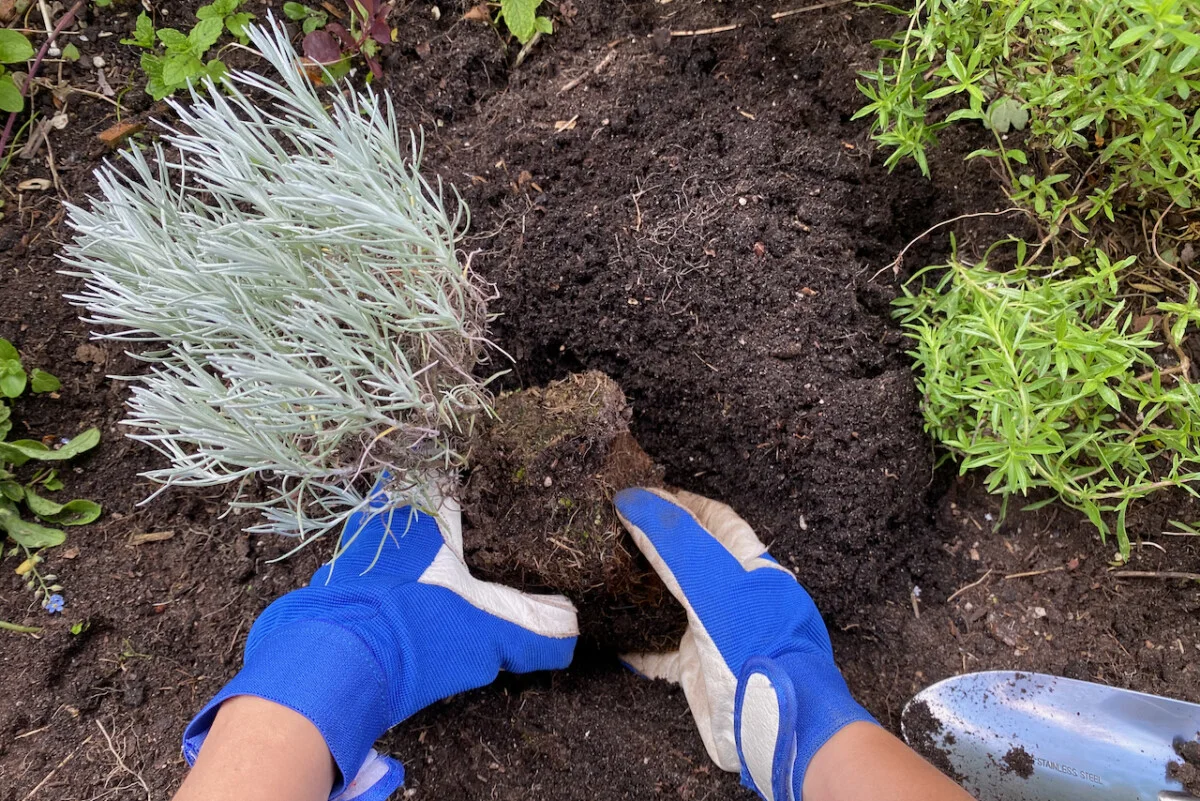
When it comes to light, the curry plant likes full sun, but it will do well in partial shade, too. There might be a difference in the speed of growth (faster in the sun) and the quantity of flowers it produces when it’s not in full sun.
The curry herb can withstand some wind and doesn’t require mulching.
3. The curry plant is a tough plant.
Just like lavender, the curry plant is a xerophyte – a plant that has adapted to a dry and hot environment. You can tell that by the tell-tale indicators that they have in common, such as the needle leather-like silver leaves and thick resinous stems.
These features are good for two reasons. First of all, it makes the curry plant drought-resistant, as long as you water it enough while it’s getting established.
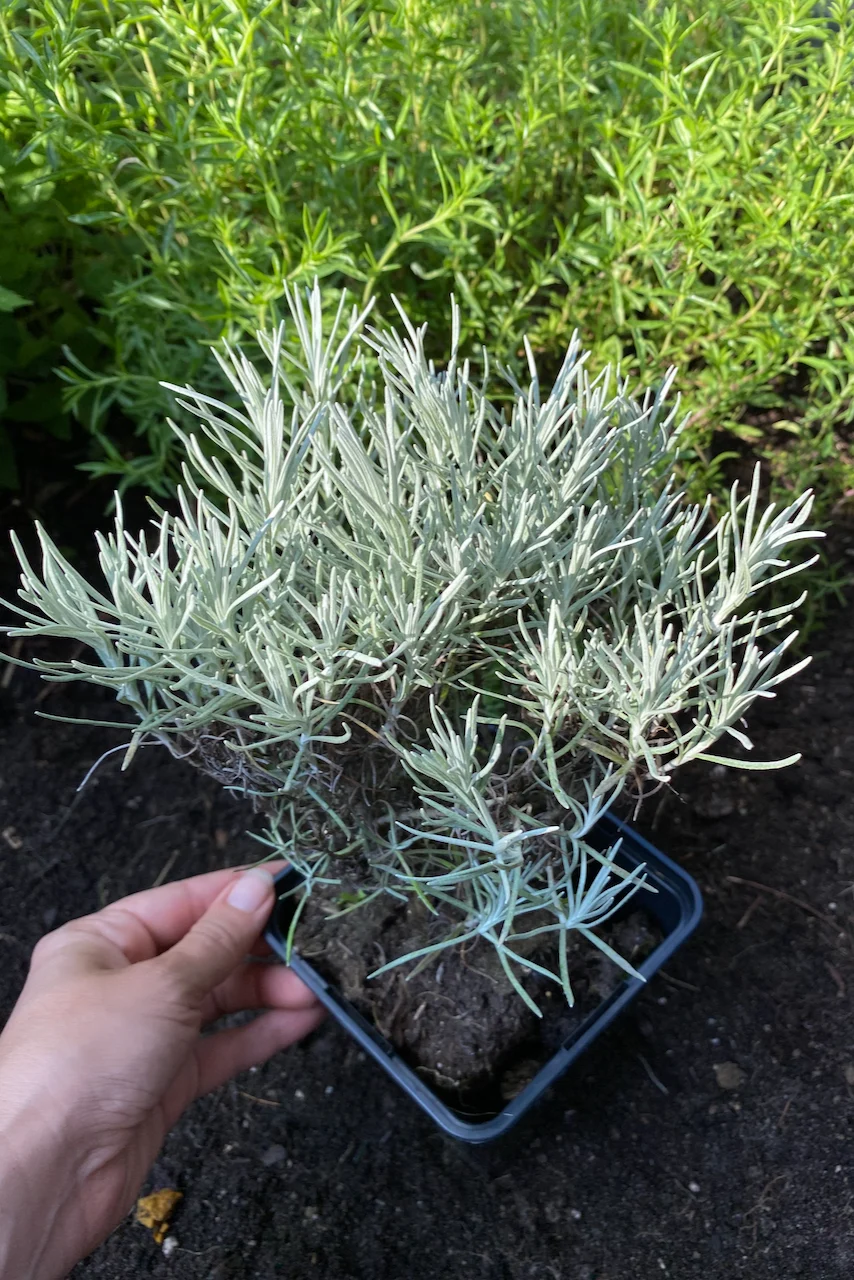
And secondly, bugs don’t really care for the fragrant tough leaves, so common garden pests leave it alone. Deer and rabbits also don’t like the smell of the plant, so they generally tend to steer clear of the spot where you’ve planted it.
However, the one thing that it’s not resistant to is prolonged hard frost. The curry plant can tolerate cold, but can’t tolerate hard frost.

As a tender perennial, the curry herb will do well in USDA zones 7 through 10. However, it might need a bit of extra protection if the temperature dips below 14F (-10C).
Which brings me to my next point.
4. You can grow the curry plant in containers.
If you live in an area that gets hard frost, you can grow the curry herb in containers and only keep it outdoors for the warmer months of the year. The rest of the time, it can be a nice little houseplant that will make your kitchen smell yummy even when you’re not cooking.
The trick is making sure you place it next to a window that gets plenty of sun – at least four to six hours a day would be ideal.

Or you can do what I’m doing to hedge my bets – plant a curry herb in the garden and keep some in pots, ready to bring indoors in late fall. (Here are other ‘commuter’ plants that can transition smoothly indoors from the garden.)
The garden center just happened to sell a cute topiary-shaped plant that will look great as a table centerpiece (and a conversation starter) next Thanksgiving.
5. It’s easy to propagate the curry plant.
If the previous point scared you into thinking that there’s no point in taking the risk of planting curry herbs if they’ll die in a frost anyway, here’s the good news. There’s very little risk when you have backups.

And you can make your own backups by taking curry plant cuttings.
You can propagate the curry plant from cuttings in the spring, summer or fall. Simply cut a few lengths of stem about four to six inches long (10-15 cm). Then strip off the bottom leaves and stick the cuttings in a well-draining pot.

Keep the pot watered, but not soggy. You should start noticing new roots coming out of the drainage holes in about four to six weeks.
If you’re a fan of easy solutions (I always am), you can also take the cuttings when you prune the curry plant in spring or in the fall.
Prune off the top and the disheveled bits – much like you would prune lavender – and then stick the strongest stem prunings in soil.

However, if you’re propagating it in the fall, remember to overwinter the cuttings in a frost-free greenhouse.
6. The curry plant flowers are a bonus.
The curry plant grows to about three feet tall (90 cm) and 2 feet wide (60 cm). It will reach its full size in about two years, so it’s only a matter of pruning and keeping it tidy after that. But don’t prune too late in spring. You don’t want to miss out on the flowers, right?
In July, the yellow flowers of the Helichrysum italicum will start to open up and they contrast beautifully against a background of silvery foliage.

Even though the Helichrysum genus is part of the Asteraceae family, the flowers resemble strawflowers (Xerochrysum bracteatum), hence its other nickname – Italian strawflower.
Pollinators love the golden blooms. But you can also cut the flowers and dry them for garlands and other floral arrangements. They’re suitable for drying because they retain their color and shape after picking.
But does the curry plant taste like curry?
The curry herb has a stronger smell than it has a taste.
It smells like curry, but the taste is pretty bland when you cook it, so you cannot use it as a curry replacement.
If you like the slight bitterness of sage or savory (as in, the Satureja herb), for example, you may enjoy the taste of the curry plant. But you can also just use it for mild seasoning and remove it before serving.

I pick the fresh young tops and crush them over salads and scrambles (tofu or eggs). It adds just for a hint of extra flavor. You can also dry the leaves as you would any other herbs, but they won’t retain all the strength of their fragrant oils.
Overall, I think you should give the curry plant a try in your garden. It’s about time we stepped outside the comfort zone of the same classic herb choices and grew something extra fun.

Get the famous Rural Sprout newsletter delivered to your inbox.
Including Sunday musings from our editor, Tracey, as well as “What’s Up Wednesday” our roundup of what’s in season and new article updates and alerts.


